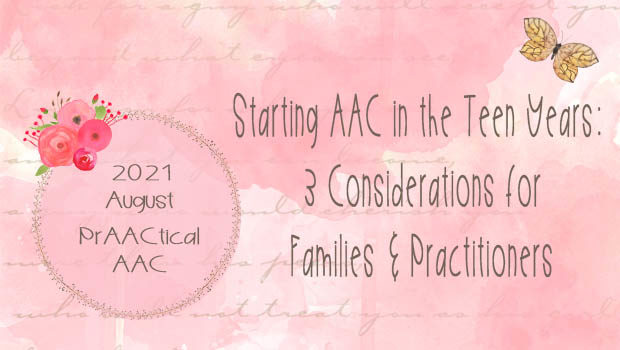Starting AAC in the Teen Years: 3 Considerations for Families & Practitioners

For children with complex communication needs, we often suggest starting AAC in early childhood as a way to support communication, speech, and language development. But in some cases, things don’t work out that way.
Children with complex bodies have a lot to learn in those early years and families often prioritize things other than communication for lots of good reasons. They may be building basic survival skills, like breathing, swallowing, and eating. They may be adjusting to feeding tubes or tracheostomies. Some may be helping children learn to sit, hold their heads up, reach for things, or develop mobility skills. Others may be dealing with difficult-to-control seizures, debilitating sleep disorders, or significant medical challenges.
Sometimes, things don’t come together to support AAC until years later.
- William’s team was learning to understand his sensory and behavioral challenges throughout much of elementary school, and exploring ways to support him so that he felt happier and more secure. They provided some AAC support, primarily PECS and a few signs, but these weren’t a focal point of his treatment plan or educational program. It wasn’t until he was about 12 that the team turned their attention to better ways for William to express himself.
- Maritza’s team also started with very small steps in AAC initially and only explored more robust AAC options when she was in middle school. She was challenged with significant motor limitations, frequent seizures, and questionable vision. During her elementary school years, Maritza was plagued with serious health concerns and missed school for weeks at a time. When she was in school, her team was trying to answer questions that would help them better support her. What could Maritza see? How should they present visual material to her so that Maritza could learn to make sense of what she was seeing? What kinds of things did Maritza like or enjoy doing? What were the best ways to manage her physical status to help Maritza stay healthy and be able to benefit from instruction? AAC didn’t become a priority until they had made good progress with those sorts of things. By then, they wondered: Was it too late?
When children enter their teen years without a functional AAC system, both families and professionals may wonder if they missed their chance to help the student develop effective communication skills with AAC.
They have not.
Teens who begin (or restart) their AAC journey can develop an array of skills with SGDs and other forms of AAC. Given the appropriate supports and services, there is every reason to believe that they will make considerable gains in their communicative abilities.
We always recommend starting with a comprehensive assessment, when possible, and using the information gleaned from that process to select appropriate AAC tools and develop an intervention plan that addresses their unique needs.
Here are some things to consider for those who are taking this path.
- Set priorities thoughtfully: Prioritize things that make communication rewarding for them. Provide vocabulary that fits their areas of interest and keep the intervention fun. The teenage years are a highly social time for many, so consider maximizing the social aspects of communication and engaging with peers. Early success is important, and focusing the intervention on things they enjoy along with well-planned support helps to generate interest in and enthusiasm for communication.
- Parent support is key: Parent training and coaching should be an integral part of the plan to help the teen get started with AAC. Help families understand the process, develop the skills to support their teen, and build habitual use of AAC facilitation skills.
- Collaborative teams lead to more effective AAC implementation: Teaming is always important, but it’s critical during the teen years when students are exposed to a much wider range of people and experiences. Regular meetings to check in on how things are going and do some joint problem-solving is one way to keep the process moving in a positive direction.
While teens sometimes get a bad rap, as many of you know, this is really a wonderful age group to work with because they’re just so much fun. They have more life experiences that we can tap into. They often have a great sense of humor. They’re starting to know themselves. And as a clinician, that’s gold.
Do you have tried-and-true strategies for starting an AAC journey during the teenage years? We’d love to hear them.
Filed under: Featured Posts, PrAACtical Thinking
This post was written by Carole Zangari
